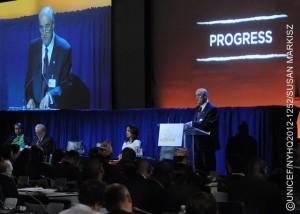Championing Children’s Rights
2012-11-04
AMMAN/ FLORENCE/ HONG KONG, 4 November 2012 – Independent human rights institutions for children play a pivotal role in idging two very different worlds: that of policymaking, government and politics, and that of children, who often find themselves marginalised and excluded from society, and their views sidelined. Children’s ombudspersons are critical advocates to champion children’s best interests and make governance fit for children.

This is the main conclusion of a new report by the UNICEF Office of Research, Championing Children’s Rights: A global study of independent human rights institutions for children– the executive summary will be unveiled at the 11th International Conference of National Human Rights Institutions, in Amman, Jordan, on November 4.
The study is globally the first comprehensive review of independent human rights institutions for children. The global trend has seen a mushrooming of public, government-sanctioned organisations that seek to ensure the voices of young people are heard, their best interests are represented, and their complaints are addressed. More than 200 such bodies have been established in over 70 countries in the last two decades.
The report takes stock of more than 20 years of their experience and highlights the purpose and potential of these institutions, what it is they do and how they operate.

In 1981 Norway was the first country to have a children’s ombudsperson, well before the 1989 adoption of the Convention on the Rights of the Child (CRC), followed by Costa Rica in 1986. Since then, the adoption of independent institutions has accelerated, with European and Latin American states being at the forefront, and African and Asian countries coming on board in the 2000s, including the most recent blossoming of discussions around the creation of child-focused independent institutions in the Middle East and North Africa.
These institutions take a variety of forms and go by many different names, ranging from ombudspersons for children, commissioners, advocates to child rights departments within human rights commissions. What these institutions have in common is the responsibility to independently monitor, promote and protect children’s rights.

A key monitoring and accountability instrument for the implementation of the CRC, they often offer direct mechanisms to hold accountability towards children and make sure that the impact of policy and practice on children’s rights is understood and recognised. They support remedy and reform when things have gone wrong or results are inadequate. They ing flexibility to political and institutional systems that can otherwise be rigid and inaccessible to the public, especially to children or those working on issues concerning them.
Their independence is core to their ability to perform that role. As the report highlights, their effectiveness is a function of both their mandate and pro-activeness and the environment they operate in.

In the context of significant economic constraint, these typically small offices are the targets of budgetary cuts. They need to constantly demonstrate their relevance in an area where the direct attribution of results is difficult.
Challenges can also be internal. Their effectiveness depends on their ability to reach out to the most marginalised children and provide an adequate remedy for rights violations. Leadership and capacity are core aspects of their ability to fulfil their mission.
As the report emphasises, children’s participation is a key factor for the mandate of the institutions, but is still an area requiring further attention. “Children themselves make proportionally few complaints to institutions, and one of the reasons may be because many complaint mechanisms remain insufficiently child-sensitive” says the report.
Legislation should provide for open and transparent processes and for the allocation of resources; governments should instruct relevant departments and public bodies at all levels to fully cooperate with the institutions; parliaments should closely consult with the institutions; civil society should support independent institutions sharing information, supporting children in making complaints, providing research and evidence to strengthen them; donors and intergovernmental organisations should provide technical assistance in establishing and strengthening independent institutions and in raising awareness of their role.
Independent institutions for children are the mirror of how a society views childhood. Its form and scope must be a result of national and local political and social processes that confer legitimacy and oad ownership to them.
Click here to read the full report |
 |









